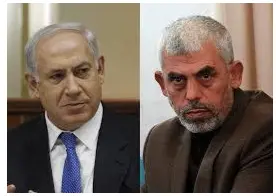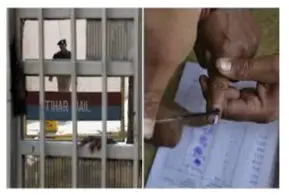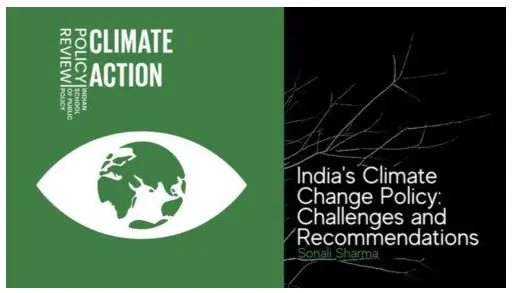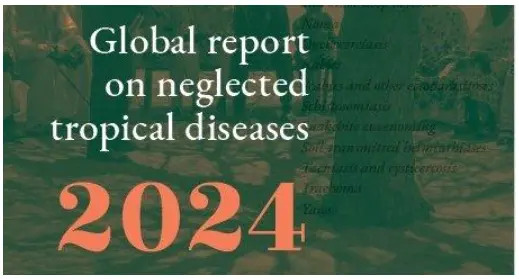Friday, 24th May 2024
Ireland, Spain, and Norway Set to Recognize Palestine
In News: Norway, Ireland, and Spain have declared their intention to officially recognize the state of Palestine, with the recognition expected to occur on May 28th.

Early Phase
- During the 19th century, Palestine was home to a diverse population, including Muslims, Christians, and Jews, coexisting peacefully.
- Zionists, aiming to establish a Jewish homeland, chose Palestine after considering other locations.
- Hitler's rise prompted increased Jewish immigration to Palestine, leading to growing tensions.
UN Partition Plan
- In 1947, the United Nations proposed partitioning Palestine, allocating 55% of the land to a Jewish state.
- Despite resistance, the plan was recommended under Zionist pressure.
- The ensuing 1948 Arab–Israeli War resulted in territorial changes, with Israel gaining control of 78% of Palestine.
Oslo Peace Process
- In 1993, Israeli and Palestinian leaders reached a breakthrough agreement in Oslo, Norway, outlining a two-state solution.
- Implementation challenges hindered progress despite initial optimism.
Issue of Statehood for Palestine
- Control over Palestinian territories remains divided despite the envisioned neighboring Palestinian state by the 1948 UN decision.
- While some nations recognize Palestine, UN membership bids have been denied.
- India advocates direct negotiations for a sovereign and viable State of Palestine living in peace with Israel.
Increasing Support for Palestine
- Recent UN General Assembly votes reflect growing international support for Palestine's full membership.
- The International Criminal Court's pursuit of Israeli leaders underscores legal ramifications.
Stand of Western Countries
- Western nations support an independent Palestinian state alongside Israel but emphasize negotiated settlements.
- Substantive negotiations have stalled since 2009.
Palestinian Statehood and India's Position
- India has maintained diplomatic relations with Palestine since 1974, supporting its statehood aspirations.
- India advocates for direct negotiations to establish a sovereign and viable Palestinian state.
Formal Recognition by Ireland, Spain, and Norway
- Ireland, Spain, and Norway announced plans to recognize Palestine, marking a significant development.
- While not immediate recognition, their support enhances Palestinian legitimacy and pressures Israel for peace talks.
Israel's Response
- Israel reacted swiftly to the recognition announcements, recalling ambassadors from Ireland, Norway, and Spain.
- The Israeli government opposes international recognition of Palestine, citing security concerns and recent conflicts.
Source: IE
Concerns Raised Over ECI's Voter Turnout Data
In News: The Supreme Court of India (SC) is scheduled to review a petition filed by the Association for Democratic Reforms (ADR), an NGO, challenging the accuracy of the voter turnout data provided by the Election Commission of India (ECI).
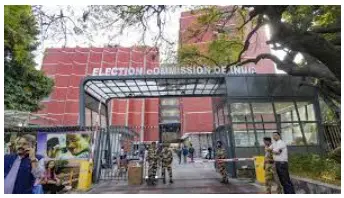
Petitions Alleging Discrepancies in Voter Turnout Data
- Overview of Allegations
- The Association for Democratic Reforms (ADR) has highlighted a notable variance of over 5% between initial voter turnout figures released by the Election Commission of India (ECI) post-polling and the final published percentages.
- Concerns have been raised by the Opposition regarding potential manipulation during the counting phase.
- Significance of Form 17C
- Form 17C, as mandated by the Conduct of Election Rules 1961, is essential for maintaining data on electors and votes polled.
- Part I of the form includes critical details such as EVM identification numbers, total electors assigned, votes recorded, and other pertinent information.
- Part II contains the outcome of the counting process, facilitating candidates to verify results and address any discrepancies.
- ADR's Petition to the Supreme Court
- ADR is urging the Supreme Court to direct the ECI to promptly upload polling station-wise voter turnout data on its website within 48 hours of each Lok Sabha election phase.
- This initiative aims to ensure transparency, especially when polling agents are unavailable to obtain Form 17C data.
- Response of the Election Commission of India
- The ECI clarified that there is no legal obligation to provide Form 17C to anyone except candidates or their agents.
- However, the ECI voluntarily disseminates voter turnout details through its app, website, and press releases, enhancing transparency.
- The ECI asserts that allegations against it are part of a consistent malicious campaign to discredit the commission.
Expert Opinion on Voter Turnout Disparities
- Experts note that while the ECI traditionally discloses absolute voter turnout numbers, this time, only percentages are being revealed.
- The delay in releasing turnout figures and the significant increase in final turnout percentages are unusual.
- To enhance transparency, experts suggest uploading scanned copies of Form 17C immediately upon submission by the Presiding Officer, particularly benefiting smaller political parties with limited resources for polling agents.
Source: TH
Economic Capital Framework (ECF)
In News: The Central Board of the Reserve Bank of India approved a record-high surplus transfer of Rs 2.11 lakh crore to the Central government for the fiscal year 2023-24, determined in accordance with the Economic Capital Framework (ECF)
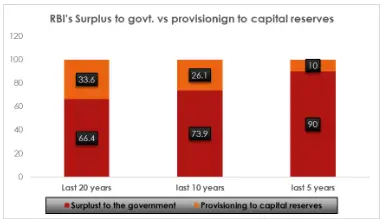
Meaning of Economic Capital Framework (ECF)
- The ECF outlines the methodology for determining risk provisions and profit distribution under Section 47 of the RBI Act 1934.
- It mandates the central bank to allocate profits to the government after setting aside provisions for bad debts, asset depreciation, and staff contributions.
Old and Revised ECF
- The previous ECF was established in 2014-15 and implemented in 2015-16.
- In 2018, the RBI formed an Expert Committee chaired by Dr. Bimal Jalan to review and propose revisions to the ECF.
- The revised ECF, adopted on August 26, 2019, incorporates recommendations from the Bimal Jalan Committee and is subject to review every five years.
Surplus Distribution Policy of the Revised ECF
- The revised policy broadens the surplus distribution target to include realized equity along with the total economic capital.
- Realized equity encompasses the RBI's capital, reserve fund, and risk provisions.
- The total economic capital should be maintained between 20.8% to 25.4% of the RBI’s balance sheet, with risk provisioning within 5.5-6.5%.
- The Contingent Risk Buffer (CRB) serves as the nation's safeguard for financial stability, allowing the RBI to act as the Lender of Last Resort.
- Surplus transfer to the government depends on realized equity levels: excess equity results in full income transfer, while deficits trigger risk provisioning before income transfer.
Surplus Transfer by the RBI
- The RBI's Central Board of Directors approved a surplus transfer of Rs 2,10,874 crore to the Central Government for the fiscal year 2023-24, doubling from the previous year.
- The CRB was increased to 6.50% for 2023-24, reflecting the economy's resilience.
- The increased dividend aims to bolster the government's fiscal position amid challenges in disinvestment receipts and tax collections.
Factors Contributing to Higher Dividend Transfers
- Increased revenue from variable repo rate auctions and revaluation gains on forex reserves contributed to higher dividend payouts.
- The RBI's income from interest rates on domestic and foreign securities, along with higher forex sales, also contributed to the surplus transfer.
- The rupee's depreciation against the dollar further bolstered surplus income and dividend transfers.
Source: TH
The BIMSTEC charter has been enforced
In News: After the inaugural charter of BIMSTEC became effective on May 20, the Bay of Bengal Initiative for Multi-Sectoral Technical and Economic Cooperation (BIMSTEC) is now able to admit new members and observers.
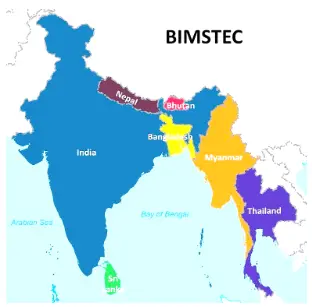
- About BIMSTEC
- BIMSTEC, established in June 1997 through the Bangkok Declaration, is an economic bloc initially comprising Bangladesh, India, Sri Lanka, and Thailand.
- Nepal joined as an observer state in 1998 and became a full-time member in February 2004, followed by Bhutan.
- The member countries include Bangladesh, India, Myanmar, Sri Lanka, Thailand, Nepal, and Bhutan, with its Permanent Secretariat located in Dhaka, Bangladesh.
- Aim of BIMSTEC
- BIMSTEC aims to counter the impacts of globalization by fostering regional growth through mutual cooperation, leveraging regional resources and geographical advantages.
- Areas of Cooperation
- Initially, BIMSTEC focused on six sectors: Trade, Technology, Energy, Transport, Tourism, and Fisheries, later expanding to 14 priority areas including Climate Change.
- Member countries take lead in specific priority areas, with India leading sectors such as Transport & Communication, Tourism, Environment & Disaster Management, and Counter-Terrorism & Transnational Crime.
- Importance of BIMSTEC
- With approximately 22% of the world's population and a combined GDP nearing $2.7 trillion, BIMSTEC countries play a significant role in global trade.
- The region has sustained notable economic growth rates, and a substantial portion of global trade passes through the Bay of Bengal annually.
- Growth of BIMSTEC as a Regional Forum
- India's renewed push for BIMSTEC following the Uri terrorist attack in 2016 revitalized the grouping, with an outreach summit hosted alongside the BRICS summit.
- BIMSTEC gained momentum as countries rallied behind India's call to boycott the SAARC summit, scheduled in Islamabad, after the Uri attack.
- Significance for Member Countries
- Member countries view BIMSTEC as an opportunity to enhance regional connectivity, access emerging markets, and balance geopolitical influences.
- For India, BIMSTEC aligns with its foreign policy priorities, facilitating closer ties with neighboring nations and advancing the Act East policy.
- Challenges
- Discord between Bangladesh and Myanmar over Rohingya refugees and China's infrastructure initiatives pose challenges.
- BIMSTEC has emerged as a battleground for influence between India and China, with China's Belt and Road Initiative excluding India and Bhutan.
BIMSTEC Charter Comes into Force
- Background
- In March 2022, BIMSTEC leaders, under Sri Lanka's chairmanship, adopted the charter during the 5th Summit.
- Charter Comes into Force
- Nepal's parliament ratified the BIMSTEC charter in April 2024, leading to its enforcement on May 20, 2024.
- With the charter in force, BIMSTEC gains legal personality, enabling structured diplomatic dialogue and facilitating deeper regional integration.
Source: TH
Foreigners Tribunals
In News: Recently, the Supreme Court (SC) put a stop to the deportation of a woman who had been deemed a foreigner by a Foreigners' Tribunal in Assam.
Functioning and Significance of Foreigners Tribunals (FTs)
- Established through the Foreigners (Tribunals) Order, 1964, FTs allow state administrations, represented by District Collectors or District Magistrates, to refer individuals suspected of being foreigners to these tribunals.
- Enacted by the Central government under Section 3 of the Foreigners Act, 1946, the Foreigners (Tribunals) Order, 1964, applies nationwide, but currently, FTs are operational only in Assam.
- In states other than Assam, illegal immigrants are typically produced before local courts and dealt with according to the provisions of the Foreigners Act, 1946.
- Following the 2019 amendment to the Foreigners (Tribunals) Order, 1964, both the Centre and states are empowered to establish FTs.
Purpose of FT
- FTs play a crucial role in the detection of suspected foreigners, with superintendents of police (SPs) and district commissioners authorized to make references to these tribunals.
- The Election Commission of India (ECI) can refer cases of Doubtful voters (D-voters) to the local SP, who then forwards them to FTs for citizenship verification.
- Individuals excluded from the final draft of the National Register of Citizens (NRC) released in August 2019 have the right to appeal before FTs to prove their citizenship.
Functions of FTs
- Upon receiving a reference against an individual, the FT serves them with a copy of the grounds for suspicion and a show-cause notice within 10 days.
- The notice specifies that the burden of proof lies with the individual to demonstrate their non-foreigner status.
- FTs afford the individual a reasonable opportunity to present their case, either in person or through legal representation, and submit supporting evidence.
- Failure to provide evidence or arrange for bail may result in detention and transfer to a detention centre as directed by the FT.
- The Supreme Court has ruled that FT decisions on an individual's nationality hold binding authority, surpassing the decisions of the government or NRC verification authorities.
Source: BB
Travel & Tourism Development Index
In News: In the recently released Travel & Tourism Development Index, India has shown improvement in its ranking compared to the previous report.
Overview of the Travel & Tourism Development Index
- The Travel & Tourism Development Index represents the second edition of an index that has evolved from the flagship index of the World Economic Forum, which has been produced since 2007.
- Developed in collaboration with the University of Surrey and with contributions from leading Travel & Tourism (T&T) stakeholders, thought leaders, and data partners.
- This index assesses the set of factors and policies facilitating the sustainable and resilient development of T&T.
- India secured the 39th position, the highest in South Asia and among other lower-middle-income economies.
- India's ranking marks a significant advancement from its 54th position in the 2021 index.
- With an overall index score of 4.25 out of 7, where 1 signifies the worst and 7 the best, India's improved ranking underscores its growing competitiveness in the global tourism landscape.
- The biennial index analyzed the travel and tourism sectors of 119 countries, evaluating them based on various factors and policies conducive to tourism development.
Source: TOI
Electric Vertical Take-Off and Landing (eVTOL) Aircraft
In News: The ePlane Company, incubated by the Indian Institute of Technology, Madras, is anticipated to introduce its e-flying taxis in Bengaluru later this year. However, despite this development, the Indian government has not yet formulated clear policies concerning eVTOL flying taxis.

Overview of Electric Vertical Take-Off and Landing (eVTOL) Aircraft
- An electric vertical take-off and landing (eVTOL) aircraft operates using electric power for vertical hovering, takeoff, and landing.
- It represents a cutting-edge development in the aerospace industry, showcasing newer technologies.
- Typically, eVTOL aircraft are designed for low-altitude urban air mobility, with most models capable of carrying only a limited number of passengers, ranging from six to eight seats.
- The technology behind eVTOLs predominantly involves distributed electric propulsion, integrating multiple motors into the airframe to enhance efficiency and safety.
- This technology has seen advancements due to progress in electric propulsion, including motor, battery, fuel cell, and electronic controller technologies. Additionally, the demand for new vehicle technology supporting urban air mobility (UAM) has further fueled its development.
- eVTOL aircraft find diverse applications, including air taxi services, delivery operations, emergency medical services (EMS), cargo transport, and recreational activities.
- These aircraft are expected to revolutionize transportation by providing on-demand mobility for both intra- and intercity travel, thereby improving connectivity between metropolitan areas and airports in the foreseeable future.
Source: DTE
Planetary Alignment
In News: In the upcoming month of June, specifically on June 3, there will be an opportunity for observers to witness a rare celestial event: the alignment of six planets in the sky.
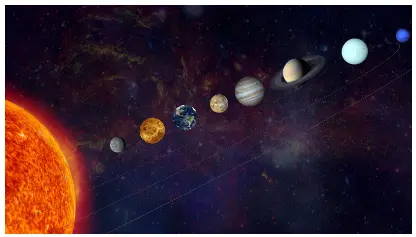
Understanding Planetary Alignment
- Planetary alignment refers to the positioning of planets in our solar system in a manner that appears to create a straight or nearly straight line when observed from Earth.
- This occurrence is primarily an optical illusion resulting from our vantage point on Earth, rather than an actual arrangement of planets in perfect alignment in space.
Aligned Planets
- Mercury, Mars, Jupiter, Saturn, Uranus, and Neptune are set to align in a configuration that resembles a straight line.
Visibility of Planets
- Although six planets align, not all of them will be observable with the naked eye due to their considerable distance from Earth.
- The presence of the Moon may further hinder visibility by distorting the view.
- Mercury and Jupiter may be challenging to spot in the sky due to their proximity to the Sun along their orbital paths.
- Mars and Saturn, albeit faint, should be visible to the naked eye.
- Observers interested in seeing Uranus and Neptune will likely require telescopes or high-powered binoculars due to their greater distance from Earth.
Source: IT
AI Agents
In News: Referred to as ‘AI agents’, GPT-4o and Project Astra are considered significantly more advanced than traditional voice assistants like Alexa, Siri, and Google Assistant.

Understanding AI Agents: Enhancing Human-Computer Interaction
- AI agents are advanced AI systems capable of engaging in real-time, multi-modal interactions with humans, including text, image, and voice.
- Unlike traditional language models, AI agents can process diverse inputs and respond naturally, leveraging sensors to perceive their environment.
- These agents are deployed in various domains such as gaming, robotics, virtual assistants, and autonomous vehicles.
- AI agents differ from large language models (LLMs) like GPT-3 and GPT-4 in several aspects:
- They offer more immersive interactions through voice, vision, and environmental sensors.
- AI agents enable real-time conversations with human-like responses, unlike LLMs that generate text.
- They possess contextual awareness, allowing for personalized and relevant responses based on interaction context.
- While LLMs are limited to text generation, AI agents can autonomously perform complex tasks like coding and data analysis.
- Potential uses of AI agents include:
- Serving as intelligent assistants for various tasks, from recommendations to appointment scheduling.
- Enhancing customer service by providing seamless interactions and resolving queries instantly.
- Acting as personal tutors in education, customizing learning experiences based on student preferences.
- Assisting healthcare professionals with real-time analysis, diagnostic support, and patient monitoring.
Source: IE
Institute of Chartered Accountants of India (ICAI)
In News: Recently, the Supreme Court affirmed a regulation implemented by the Institute of Chartered Accountants of India (ICAI), which prohibits chartered accountants from taking on more than a certain number of tax audit assignments within a single financial year.
Overview of the Institute of Chartered Accountants of India (ICAI)
- The ICAI is a statutory body established under the Chartered Accountants Act, 1949, by the Parliament of India, with the primary purpose of regulating the profession of Chartered Accountancy within the country.
- It operates under the administrative oversight of the Ministry of Corporate Affairs, Government of India, and is headquartered in New Delhi.
- As the second largest professional body of chartered accountants globally, the ICAI is responsible for managing the affairs of the profession through its Council.
- The Council, comprising 40 members, is tasked with governance in accordance with the Chartered Accountants Act, 1949, and the Chartered Accountants Regulations, 1988.
- Functions of the ICAI include regulating the accountancy profession, conducting Chartered Accountancy courses and examinations, organizing continuing professional education, offering post-qualification courses, and formulating accounting standards and auditing procedures.
- Additionally, the ICAI lays down ethical standards, monitors quality through peer review, ensures performance standards of its members, exercises disciplinary jurisdiction, conducts financial reporting reviews, and provides input on policy matters to the government.
Source: LL
Protectors of the Forest: Tribal Guardians
In News: The article underscores the Indian President's call for Indian Forest Service officers to merge traditional tribal knowledge with modern conservation methods, recognizing its significance in forest preservation and climate change mitigation.
Roles of Tribal Population in Forest Conservation
- Sustainable Resource Utilization
- Tribal communities have developed sustainable methods of resource extraction from forests.
- For instance, every resource collection practice done by Kadars tribes of South India, whether honey, firewood, resin, or herbs, is designed to allow for regeneration.
- Similarly, the Bhotias of Central Himalayas inspect the maturity of leaves before harvesting medicinal plants to prevent overharvesting.
- Preservation of Sacred Groves
- Many tribes consider certain forest areas as sacred groves dedicated to folk deities.
- For example, the Garasia tribes in Sirohi district, Rajasthan have preserved patches of forests termed sacred groves, protecting threatened plant species listed in the IUCN Red List.
- Rotational Farming and Grazing
- Tribes like the Gond, Pradhan, and Baiga of Madhya Pradesh practice Utera farming, where the next crop is sown before harvesting the primary one, utilizing existing soil moisture.
- They also follow the Badi cropping system, planting fruit trees along the periphery to prevent soil erosion.
- Sustainable Fishing Practices
- Unlike harmful methods like dynamiting, tribes employ sustainable fishing techniques.
- For instance, the Wancho and Nocte tribes of Tirap district, Arunachal Pradesh create obstructions in streams using bamboo and stones to trap fish, distributing the catch among the community (Bheta method).
- Wildlife Protection through Beliefs and Totems
- Tribal beliefs and totems restrict the culling of certain animals and plants.
- For example, for the Adi tribes of Arunachal Pradesh, tigers, sparrows, and pangolins are well-wishers of humankind and are not hunted.
- Community-based Conservation Efforts
- Some tribes have declared parts of their forest land as "Community Conserved Areas" governed by locals.
- For instance, the Idu Mishmis have taken this step, while the Bishnoi Tiger Force, an environmental campaign group, actively fights against poaching and rescues injured animals in Rajasthan.
Key Challenges Encountered by Tribals in India
- Land Alienation and Displacement
- Tribal communities have faced widespread displacement due to various development projects, such as mining, dams, and infrastructure projects, leading to the loss of their traditional lands and disruption of their way of life.
- Lack of Implementation of Forest Rights Act
- The Scheduled Tribes and Other Traditional Forest Dwellers (Recognition of Forest Rights) Act, 2006, aimed to recognize the rights of forest-dwelling communities over land and resources.
- However, its implementation has been slow and ineffective, with many tribes facing delays, harassment, and illegal evictions.
- Threats to Traditional Livelihood Practices
- Traditional livelihood practices of tribal communities, such as shifting cultivation, hunting, and gathering, are increasingly under threat due to conservation policies and restrictions imposed by forest departments.
- Loss of Traditional Knowledge and Cultural Erosion
- With the younger generation of tribals migrating to urban areas in search of better opportunities, there is a risk of losing the traditional knowledge and practices passed down through generations.
- Impact of Climate Change
- Tribal communities, heavily dependent on natural resources, are among the most vulnerable to the impacts of climate change.
- For instance, the Khasi tribe in Meghalaya has witnessed a decline in their traditional agricultural practices due to changing rainfall patterns and temperature increases.
Measures to Integrate Tribal Empowerment with Forest Conservation
- Eco-tourism Initiatives
- Promoting eco-tourism initiatives led by tribal communities can provide them with alternative livelihood opportunities while preserving their cultural heritage and traditional knowledge.
- Tribal Forest Guardians Program
- Implementing a "Tribal Forest Guardians" program, where members of tribal communities are trained and employed as forest guards or eco-guides.
- Tribal Knowledge Banks
- Documenting and integrating traditional ecological knowledge of tribal communities into modern conservation strategies.
- Forest Product Value Addition and Marketing
- Establishing value-addition and marketing initiatives for forest products collected by tribal communities.
- Participatory Forest Management
- Promoting participatory forest management models, where tribal communities are actively involved in decision-making processes related to forest conservation and management.
|
UPSC Previous Year Questions Prelims (2019) Q. Consider the following statements about Particularly Vulnerable Tribal Groups (PVTGs) in India:
Which of the statements given above are correct? (a) 1, 2 and 3 (b) 2, 3 and 4 (c) 1, 2 and 4 (d) 1, 3 and 4 Ans: (c) Prelims (2013) Q.2 Under the Scheduled Tribes and Other Traditional Forest Dwellers (Recognition of Forest Rights) Act, 2006, who shall be the authority to initiate the process for determining the nature and extent of individual or community forest rights or both? (a) State Forest Department (b) District Collector/Deputy Commissioner (c) Tahsildar/Block Development Officer/Mandal Revenue Officer (d) Gram Sabha Ans: (d) |
Source: IE
Share the article
Edukemy’s Current Affairs Quiz is published with multiple choice questions for UPSC exams
MCQ
Get Latest Updates on Offers, Event dates, and free Mentorship sessions.

Get in touch with our Expert Academic Counsellors 👋
FAQs
UPSC Daily Current Affairs focuses on learning current events on a daily basis. An aspirant needs to study regular and updated information about current events, news, and relevant topics that are important for UPSC aspirants. It covers national and international affairs, government policies, socio-economic issues, science and technology advancements, and more.
UPSC Daily Current Affairs provides aspirants with a concise and comprehensive overview of the latest happenings and developments across various fields. It helps aspirants stay updated with current affairs and provides them with valuable insights and analysis, which are essential for answering questions in the UPSC examinations. It enhances their knowledge, analytical skills, and ability to connect current affairs with the UPSC syllabus.
UPSC Daily Current Affairs covers a wide range of topics, including politics, economics, science and technology, environment, social issues, governance, international relations, and more. It offers news summaries, in-depth analyses, editorials, opinion pieces, and relevant study materials. It also provides practice questions and quizzes to help aspirants test their understanding of current affairs.
Edukemy's UPSC Daily Current Affairs can be accessed through:
- UPSC Daily Current Affairs can be accessed through Current Affairs tab at the top of the Main Page of Edukemy.
- Edukemy Mobile app: The Daily Current Affairs can also be access through Edukemy Mobile App.
- Social media: Follow Edukemy’s official social media accounts or pages that provide UPSC Daily Current Affairs updates, including Facebook, Twitter, or Telegram channels.

